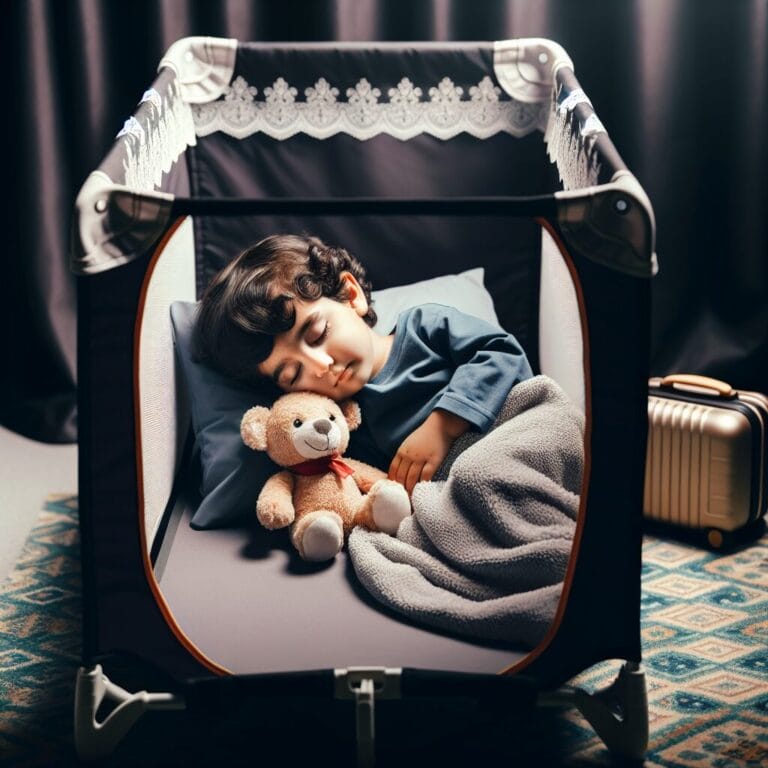
Mastering Sleep Routines: Essential Tips for Preschoolers Who Travel Frequently
Table of Contents
- Introduction
- Understanding Sleep Needs for Preschoolers
- Preparing for Travel
- Creating a Sleep-Conducive Environment While Traveling
- Maintaining Sleep Routines on the Go
- Dealing with Time Zone Changes
- Tips for Handling Sleep Disruptions
- Encouraging Good Sleep Habits Post-Travel
- Conclusion
- Frequently Asked Questions
Introduction
When mapping out the day plan on vacation, consider weaving in some wind-down time for your preschooler to help combat the havoc that multiple time zones can cause. Kids sleep habits are like delicate puzzles; one missing piece and the whole picture of a good night’s sleep can fall apart. While it’s tempting to cram every moment with fun activities, remember that a little rest goes a long way. To smoothly handle bedtime switches from one location to another, it’s wise to keep a few constant bedtime signals. Having their favorite book or stuffed animal travel with you gives your child sleep muscle memory cues, making falling asleep in an unfamiliar sleep space less daunting.
If you’re traveling across different time zones, it’s smart to gradually shift your child’s bedtime routine closer to the local time of your destination a few days before departure. This pre-travel adjustment helps align their circadian rhythm and could mean fewer struggles at bedtime upon arrival. And if you can create a dark sleep space akin to home – think portable blackout curtains or sleeping bag – it’ll further cement those zzz’s on the go.
Remember, kids are adaptable, especially when they know what’s expected. By setting clear sleep rules and sticking to them as much as possible (yes, even when there is arguing), parents reinforce the security that comes from predictability. Once back home, swiftly returning to their established schedule will mend any temporary bad sleep habits picked up along the journey. Plus, nothing beats witnessing your big kid sleeping soundly after an action-packed trip – it’s proof of mastering the art of travel bring-alongs for ultimate snooze success!

Understanding Sleep Needs for Preschoolers
Did you know that preschoolers need about 10 to 13 hours of sleep each day, including naps? To achieve this, setting a defined bedtime routine is like a secret recipe for ensuring your little explorer gets the rest they need—even when hopping through different time zones. Without enough shut-eye, young children may show symptoms like crankiness, hyperactivity, or even difficulty paying attention during the daylight adventures. It’s crucial to identify these signs early so as not to mistake them for just “travel fatigue,” which can lead to long-term bad sleep habits.
Creating a familiar and dark sleep space is essential while on vacation. Portable items like a white noise machine can help drown out unfamiliar sounds and mimic the home environment—especially useful if your child sleeps independently at home. Even in new sleep spaces, the magic combo of their favorite book and stuffed animal can work wonders in making them fall asleep easily. This travel bring-along strategy maintains consistency and provides comfort from home while navigating time changes.
Let’s focus on fresh air and early bedtimes too. We’ve all felt it—the invigorating effect of outdoor activities during the day leading to a deeper slumber at night. Schedule activities that involve plenty of sunshine and exercise; they help adjust your child’s circadian rhythm more quickly to local time. An occasional earlier bedtime might be necessary after an energy-packed day or when managing traveling multiple time zones—a small tweak with big benefits!
Return home comes next: reintroducing your child back into their usual sleep schedule should start sooner rather than later to maintain those good habits learned from infancy. Consistency is key; by swiftly returning to their established routine upon return home, you’re solidifying healthy patterns that will benefit them well beyond these adventurous years.
Overall, while mastering preschooler sleep routines on-the-go might seem daunting at first glance, with some planning and adaptability (and maybe an extra cuddle or two), you’ll find both you and your child can still sleep great after an exciting day discovering new horizons together!
Preparing for Travel
Packing for a trip with your preschooler can sometimes feel like preparing for a space mission—every item has its place and purpose, especially when it comes to ensuring your little one’s sleep comfort is not compromised. Start with the basics: their favorite stuffed animal and bedtime book create a sense of familiarity, essential for falling asleep easily in new environments. Include a white noise machine to mask unfamiliar sounds, and don’t forget a portable night light for consistent lights out, helping maintain those precious kids’ sleep habits.
Let’s talk strategy—before you embark on your adventure, involve your child in the travel plans. Chat about where you’re going and how exciting it will be to see new places. This can reduce any anxiety that could lead to bad sleep habits while away from home. Familiarizing children with what’s ahead makes them part of the process, setting their expectations right and aligning them closer to the family’s vacation sleeping tips.
Adjusting your child’s sleep schedule doesn’t have to be daunting. A gradual approach works wonders; start by shifting their bedtime closer to the local time of your upcoming destination. If you’re traveling across multiple time zones, this tactic allows your child’s circadian rhythm to adapt without the shock of a sudden change. Here’s how you can do it: if flying east, put them to bed earlier each night before departure; if westward, let them stay up later.
Once at your destination—and after taking full advantage of fresh air during daytime activities—stick as closely as possible to early bedtimes aligned with home time zone routines or adjust slightly for local time cues. Remember that while naps are essential too, they shouldn’t interfere with catching those regular nightly zzz’s.
By covering these bases before take-off and keeping a cool head when handling bedtime switches or overcoming any sleep space challenges upon arrival (like making that hotel room dark enough), you’re paving the way for smooth slumbers under foreign stars. And once you return home, swiftly resuming their standard snooze pattern will help reinforce these well-established sleep rules without missing a wink!
Creating a Sleep-Conducive Environment While Traveling
Ever wondered how much your little one’s sleep haven at home can impact their rest on the road? Selecting accommodations that champion good child sleep is a savvy move parents shouldn’t overlook. Scan for places boasting quiet rooms away from noisy elevators or streets, because just like adults, a peaceful environment helps kids drift into dreamland. Ensure the room mimics that dark sleep space they’re used to; this could mean packing those extra handy portable blackout blinds. And whenever possible, scope out hotels or rentals with separate sleeping areas so older kids can settle without grown-up chatter interrupting their starry snoozes.
Bringing along comfort items from home isn’t just about filling suitcases; it’s about filling your child’s sleep space with familiarity and security. That worn-out stuffed animal or tattered favorite book isn’t merely another thing to pack—it’s a piece of home time zone comfort that whispers “sweet dreams” in an unknown place. These treasures from home aid in falling asleep easily by keeping bedtime routines anchored no matter where you find yourselves in the world.
Adjusting light and noise levels on vacation creates an optimal setting conducive to maintaining those cherished kids’ sleep habits—even when contending with a bewildering array of new time zones. A compact white noise machine can be as reassuring as an old lullaby, drowning out strange sounds while helping preserve your child’s precious sleep cycle despite the chaos of travel bring-alongs. If you find yourself caught in bright evening locales or places where daybreak comes too early, remember those portable shades and perhaps even invest in a comfy sleeping bag designed for young travelers—these are superhero tools for battling unwanted rays or rumbles.
In tackling these tasks head-on, families become travel-savvy slumber experts, ensuring every adventure includes restful nights for their dynamic young explorers. By creating familiar sleep spaces separate from daily excitement and anticipating each possible disturbance to their circadian rhythm, guardians can foster a voyage filled with wonder by day and serenity by night—truly mastering preschooler sleep routines while traversing the globe.
Maintaining Sleep Routines on the Go
Traveling through time zones with a pint-sized companion in tow can turn the most meticulous sleep schedule into a high-seas adventure. But fear not, for mastering preschooler bedtime routines while circumnavigating the clock is an art form that begins with synchronizing your watches to local time. Staying true to familiar rituals is key; even as landscapes change, the trusty sequence of bath-book-bed acts as an anchor in turbulent seas, providing youngsters with a comforting sense of continuity that says “it’s sleepy-time” no matter the longitude.
It’s essential to maintain consistent sleep and wake times, adjusting incrementally as you hop from one meridian to another. This steadfastness helps keep your child’s internal clock ticking along without skipping too many beats—mercifully avoiding those all-too-familiar 3 AM wide-eyes staring at you from the darkness. And when it comes to napping on-the-go? That’s a daytime voyage worth charting: plan nap landings post-lunch or pre-afternoon excursions, ensuring these snoozy pitstops don’t mutiny against bedtime peace treaties later on.
But what about those inevitable moments when jet lag looms like storm clouds on the horizon? Here’s where strategic sunlight exposure comes into play—like a natural compass guiding circadian rhythms toward calm waters. Morning rays act as a sparkling wake-up call while evening dim light signals it’s time to wind down. Factor in some fresh air and active playtime during the day; this duo works like magic sand in the eyes, drawing forth deeper slumber come nightfall.
And though older kids might boast sea legs strong enough to withstand choppy sleep schedules, ensure they aren’t left adrift by maintaining clear expectations: same bat-time, different bat-channel! So whether you’re navigating across vast oceans of time zones or just puddle-jumping overnight stays, embrace travel bring-alongs that signal bedtime consistency—be it sleeping bags or plush first mates—and watch as your little buccaneer sails smoothly into nighttime nirvana.
Ahoy there! With these navigational tips etched on your captain’s log, setting sail for slumber-filled horizons becomes less daunting and more of an explorative delight. Adventure awaits by day and restorative rest by night—it’s a balance achievable with a measured mix of preparation and flexibility on this grand family journey called Life.
| Aspect | Action | Purpose |
|---|---|---|
| Adjusting to Local Time | Set watches to local time upon arrival. | Helps synchronize the body’s internal clock to the new environment. |
| Preserving Bedtime Rituals | Continue with the familiar sequence of bath, book, and bed. | Provides a comforting sense of continuity for the child. |
| Consistent Sleep/Wake Times | Maintain regular sleep and wake times, adjusting gradually. | Keeps the internal clock regular, preventing major disruptions. |
| Napping Strategy | Plan naps after lunch or before afternoon activities. | Ensures that naps support, rather than interfere with, nighttime sleep. |
| Managing Jet Lag | Utilize strategic sunlight exposure. | Helps adjust circadian rhythms to the new timezone. |
| Daytime Activity | Engage in fresh air and active play during the day. | Promotes tiredness and deeper sleep at night. |
| Clear Expectations for Older Kids | Maintain clear sleep schedule expectations. | Helps older children adapt without confusion. |
| Travel Sleep Aids | Bring along items that signal bedtime (e.g., sleeping bags, plush toys). | Signals to children that it’s time to sleep, even in a new environment. |
| Balance | Combine preparation with flexibility during travel. | Makes the journey enjoyable and ensures restorative rest. |
Dealing with Time Zone Changes
Ah, the grand family adventure—where each day is packed with discovery, and every night should ideally end with a restful slumber for your little explorers. But as the day fades and bedtime nears, parents often find themselves asking: How can we keep our preschooler’s sleep routine in check while navigating time changes? Fear not! With some know-how, adjusting sleep times to align with new time zones doesn’t have to be as complicated as a pirate’s treasure map.
First up on this sleep quest—time zone trekking. Let’s dig into that suitcase of tricks to ease the shift in schedule:
– Start by moving bedtime incrementally before you set off on your voyage. If heading east, coax your little ones under the covers 15 minutes earlier each night; if westward bound, let the pillow fights last just a bit longer.
– Once you’ve dropped anchor at your destination, match meal and activity times to local patterns. This will help reset their internal clocks to ‘local time’ without walking the plank of crankiness.
But wait—what about when the sun plays peek-a-boo at odd hours? Here’s where Mother Nature lends a hand:
– Expose little eyes to morning light; it’ll signal their brains that it’s time for action stations!
– As evening approaches, dim those lights like you’re prepping for an undercover escapade—darkness tells their bodies it’s nearly time for dreams of swashbuckling adventures.
Don’t forget to pack days with plenty of shipshape activities:
– Schedule treasure hunts (or perhaps park visits) and plenty of playtime on deck (or any open space you can find). Not only does this make for rosy-cheeked stories at dinner, but active days lead to sleepy heads come nightfall.
Mastering these tips is like finding buried treasure; it turns maintaining serene sleep schedules from myth into reality—even as you sail through different time zones. So hoist those sails and enjoy setting sail towards dreamland together—the ultimate capstone to each day’s chapter in your family’s travel chronicles.

Tips for Handling Sleep Disruptions
Did you know that the rhythm of waves can soothe a restless child? Keeping this natural lullaby in mind, we delve into the art of serenading our little voyagers into dreamland while on the move. Calming techniques are akin to a captain’s steady hand at the helm, guiding preschoolers gently towards sleep amidst the excitement of travel. One such technique is incorporating a low-tech version of white noise—the hum of a fan or soft background music—to recreate the comforting audio blanket they’re used to at home. The gentle rhythm can be just what’s needed to coax those peepers shut.
But sometimes, even with the best-laid plans, sleep issues may crop up like uncharted islands. Perhaps your big kid sleeping angel suddenly morphs into a night-time wiggler, resistant to slumber’s call. Practical solutions come from both preparation and improvisation—like engaging in quiet play that mimics bedtime rituals at home or using calming scents known for their snooze-inducing magic. And when overstimulation is the culprit behind bedtime mutinies, retreat back to basics with simple breathing exercises or an impromptu storytelling session beneath an imaginary star-filled sky.
Now, while most challenges have their fixes, there comes a time when calling on extra reinforcements makes sense. If restless nights become more than just an occasional squall—disrupting your child’s development and well-being—it’s prudent to drop anchor and seek professional help. Pediatricians or sleep specialists can navigate through persistent sleep difficulties that go beyond time zone changes and vacation sleeping tips; they have maps to hidden treasures—strategies ensuring everyone in your crew gets the rest needed for tomorrow’s adventures.
Whether it’s managing post-playground energy spikes or diffusing pre-sleep jitters with tales of far-off lands, weaving these new insights into your travel tapestry promises smoother sailing ahead. Remembering that each child sleeps uniquely will help tailor approaches that align with their individual needs—creating sleep spaces separate from daytime bustle where relaxation takes center stage—and by doing so, make sure your young explorers wake up refreshed and ready for whatever treasures await them in distant lands or just around the bend.
Encouraging Good Sleep Habits Post-Travel
Traveling can spin the compass of a child’s sleep pattern, but the journey back to familiar shores doesn’t have to be riddled with restless nights. Once your vessel docks at home base after navigating through time zones and adventures, it’s key to hoist the flag of normalcy straight away. Here’s a treasure map back to tranquil waters: re-establish those precious zzz’s by charting a course that mirrors pre-vacation bedtime routines. The trick is in timing—keeping evening rituals aligned with the child’s home time zone ensures that their circadian rhythm isn’t left floundering.
But avast! There’s more than just sticking to a schedule; let’s sprinkle some magic dust on this return voyage with positive reinforcement. Celebrating each night your young one embarks on solo slumber expeditions without a fuss adds wind to their self-esteem sails. Chart their progress on a starry reward chart or share tales of their bedtime bravery—it’ll be like shining lighthouse beams on their path towards sleep independence.
Keeping an eye on the horizon for any lingering fog is smart navigation too. Post-travel, monitor how your little sailor sleeps—if there are signs of choppy seas like frequent awakenings or early morning squawks, you may need to adjust course slightly. Perhaps it’s tweaking nap times or reassessing that dark sleep space—like ensuring that stuffed animal sentry stands guard all night or confirming the white noise machine hums its reassuring tune.
Real-life swashbuckling parents know that mastering preschooler sleep routines while traveling isn’t about smooth sailing every night; it’s about being prepared to steer through storms and celebrate calm seas alike. By observing how well your child adapts post-adventure, you ensure they’re equipped for dreamy voyages ahead—because as every seasoned captain knows, understanding the sea (or in this case, sleep!) is an unpredictable but ultimately rewarding adventure.
Conclusion
Ahoy, parent pirates on the high seas of slumber! Let’s talk treasure—the golden nuggets of sleep success for your little buccaneers while traversing uncharted territories. Beyond the map of bedtime routines and time zone navigation lies the lesser-sailed waters of daytime dozing. Yes, ye heard right—naps! While gallivanting across lands aplenty, maintaining a mini-matey’s nap can be as crucial as their nightly snooze. Why, you ask? A well-timed siesta not only wards off cranky sea monsters but keeps your kiddo’s internal compass steady, ensuring they don’t drift into the rough sea of overtiredness.
Scheduling activities is key to walking this plank gracefully; aim for morning explorations when energy swells like high tide. As the sun reaches its peak, encourage downtime or quieter play, setting sail towards that sweet spot—a restful afternoon nap. This not only helps them fall asleep easily at night but also makes for happier travelers keen for evening escapades or cozy cuddles with their favorite book.
But what if your young sailor resists the call of their sleeping bag in foreign lands? Stay the course with patience and a sprinkle of creativity—transform that hotel room into a dark sleep space cavern where stuffed animal shipmates stand guard over dreams filled with adventure.
Remember these pearls as you navigate bedtime while traveling multiple time zones: even amidst uncertainty and new routines, kids’ sleep habits are an anchor that holds fast. With consistency lights from home time zone shores and adjusting sails when needed, you’ll help your child fall asleep under starry skies near and far. And just like guiding a ship back to harbor after a long voyage, returning home means swiftly re-establishing familiar rhythms—those solid sleep rules arguing against any bad sleep habits picked up along the way.
So here’s a final thought: instilling good sleep habits during these formative years is like charting a course for lifelong wellness—a true north worth pursuing for every family navigating childhood’s exciting odyssey. Keep those circadian rhythms steady and watch as your little ones grow into big kid sleeping captains in their own right—the ultimate quest in mastering preschooler sleep routines while traveling!



